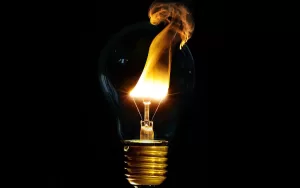
Illuminate The World: LED (Light Emitting Diode)
September 15 2023 
Inquiry
Global electronic component supplier AMPHEO PTY LTD: Rich inventory for one-stop shopping. Inquire easily, and receive fast, customized solutions and quotes.
QUICK RFQ
ADD TO RFQ LIST
The advent of LEDs in the modern era has brought about a significant shift in the way we illuminate our environment, thereby transforming the lighting technology landscape. In this article, we will delve into the marvels, potentials, and pragmatic uses of LEDs, elucidating their exceptional characteristics and advantages.
What is LED?

How LED Works?
LEDs work based on a phenomenon called electroluminescence. Electroluminescence is the process by which light is emitted from a material when an electric current passes through it. LEDs are made up of several layers of semiconductor materials. The two main layers are the P-type (positive) layer and the N-type (negative) layer. These layers are typically made of materials such as gallium arsenide (GaAs), gallium nitride (GaN), or indium gallium nitride (InGaN). When a voltage is applied across the LED, the P-type layer becomes positively charged, and the N-type layer becomes negatively charged. This creates an electric field at the junction between the two layers, known as the P-N junction. Within the P-N junction, there are free electrons in the N-type layer and positively charged "holes" in the P-type layer. When the electric current flows from the P-type layer to the N-type layer, the electrons and holes combine at the junction. As the electrons recombine with the holes, they release energy in the form of photons, which are particles of light. The energy of the photons determines the color of the light emitted by the LED. Different semiconductor materials and doping techniques are used to create LEDs that emit different colors, including red, green, blue, and various combinations that produce white light. To control the color and intensity of the emitted light, additional layers and materials may be added to the LED structure. For example, phosphor coatings can be applied to LEDs to convert the blue light emitted by the LED into a broader spectrum, resulting in white light. The efficiency of LED light production is one of the key advantages of LEDs. Traditional incandescent bulbs waste a significant amount of energy as heat, whereas LEDs convert a higher percentage of electrical energy into light. This makes LEDs more energy-efficient and environmentally friendly. LEDs can be assembled into various configurations, including individual components, arrays, and panels, depending on the specific application. They are commonly used in lighting fixtures, displays, indicators, and other electronic devices. Overall, the operation of an LED is based on the principle of electroluminescence, where an electric current passing through a semiconductor material produces light. This technology has revolutionized the lighting industry and offers numerous benefits in terms of energy efficiency, durability, and versatility.What can LED be Used for?
LEDs have a wide range of applications due to their energy efficiency, versatility, and long lifespan. Here are some common uses of LEDs: Lighting: LEDs are widely used for residential, commercial, and outdoor lighting applications. They are found in light bulbs, downlights, strip lights, and floodlights. LED lighting offers energy savings, durability, and the ability to produce a variety of colors and intensities. Display and Signage: LEDs are commonly used in electronic displays and signage. They are found in digital billboards, scoreboards, information boards, and large outdoor screens. LEDs provide bright, high-contrast displays and can be arranged to create dynamic and eye-catching visuals. Automotive Lighting: LEDs are increasingly used for automotive lighting systems, including headlights, taillights, and interior lighting. LED headlights offer improved visibility, energy efficiency, and a longer lifespan compared to traditional halogen or xenon headlights. Backlighting: LEDs are used for backlighting in televisions, computer monitors, and mobile devices. LED backlights offer better energy efficiency, thinner profiles, and more precise control over brightness and color compared to traditional fluorescent backlights. Decorative Lighting: LEDs are popular for decorative lighting purposes, such as holiday lights, string lights, and architectural lighting. They offer versatility in terms of color options, brightness control, and programmable lighting effects. Street Lighting: Many cities are transitioning to LED street lighting due to its energy efficiency and long lifespan. LED streetlights provide improved visibility, reduced energy consumption, and lower maintenance costs compared to traditional street lighting technologies. Indoor Plant Growth: LEDs with specific wavelengths of light can be used for indoor gardening and plant growth. These specialized LED grow lights provide the necessary light spectrum for photosynthesis and can be tailored to meet the specific needs of different plants. Medical and Scientific Applications: LEDs are used in various medical and scientific applications, including phototherapy, microscopy, and fluorescence imaging. LED-based devices provide precise and controllable light sources for diagnostic and research purposes. Consumer Electronics: LEDs are used in a wide range of consumer electronic devices, such as smartphones, tablets, and wearable technology. They are used for indicators, notification lights, and backlighting for displays. Energy-efficient Solutions: LEDs are employed in energy-efficient solutions, such as smart lighting systems and home automation. LED-based smart bulbs can be controlled remotely, offer customizable lighting options, and integrate with other smart devices for energy management.LED with Resistor
When using an LED in a circuit, it is often necessary to include a resistor in series with the LED to limit the current flowing through it. This is important because LEDs are sensitive to excessive current and can be damaged if too much current passes through them. The resistor connected in series with the LED is known as a current-limiting resistor. Its value is chosen based on the forward voltage drop of the LED and the desired current flowing through it. The forward voltage drop is the voltage required for the LED to turn on and emit light. To calculate the value of the current-limiting resistor, you can use Ohm's Law, which states that the current (I) flowing through a resistor is equal to the voltage (V) across it divided by its resistance (R). Here I provide some tips for selecting a resistor for an LED: Determine the forward voltage (Vf) of the LED: Each LED has a specific forward voltage drop, which is the voltage required for it to turn on and emit light. Check the datasheet or specifications of the LED to find the forward voltage value. Determine the desired current (If) for the LED: Decide on the desired current that you want to flow through the LED. This current value will depend on factors such as the LED's maximum current rating, the desired brightness, and efficiency. Common LED currents range from 5mA to 20mA. Calculate the resistor value: Once you have the forward voltage (Vf) and desired current (If), you can calculate the resistor value using Ohm's Law. The formula is R = (V_source - Vf) / If, where V_source is the supply voltage. Choose the nearest higher standard resistor value: Resistors are available in standard values, such as the E12 or E24 series. Select the nearest higher resistor value to the calculated value to ensure that the LED operates within the desired current range. Consider power rating: Ensure that the power rating of the resistor is sufficient to handle the power dissipation. The power rating can be calculated using P = I^2 * R, where I is the current flowing through the resistor and R is the resistor value. Make sure the chosen resistor has a power rating greater than the calculated power. Check for available resistor sizes: Consider the physical size and package of the resistor. Larger resistors may dissipate heat better, which can be important for high-power LEDs. Test and adjust as needed: Once you have selected and connected the resistor, test the LED circuit to ensure that it operates as intended. If the brightness is too low or too high, you can adjust the resistor value accordingly.LED Kit
An LED kit typically refers to a collection or assortment of LED diodes that are packaged together as a set. These kits are often sold for hobbyists, electronics enthusiasts, or individuals who want to experiment with LEDs or build their own electronic projects. LED diode kits can include a variety of LED types, colors, sizes, and specifications. The specific contents of a kit can vary depending on the manufacturer and the intended purpose of the kit. Some LED diode kits may focus on providing a range of colors, while others may include different sizes or variations in brightness. Here are some possible components that you might find in an LED diode kit: LED diodes: These are the main components of the kit. LED diodes come in different sizes (such as 3mm, 5mm, or surface mount), and colors (such as red, green, blue, or white), and may have different specifications (such as forward voltage, forward current, or luminous intensity). Resistors: LED diodes often require current-limiting resistors to ensure the appropriate current flows through them. Some LED diode kits may include a selection of resistors suitable for use with the included LEDs. Breadboard or PCB: Some LED diode kits may provide a breadboard or printed circuit board (PCB) for easy prototyping and experimenting. These boards allow you to connect and test the LEDs and other components without the need for soldering. Jumper wires: Jumper wires are used to connect the components on the breadboard or PCB. They enable easy and temporary connections between different elements of the circuit. Other components: Depending on the kit, you may find additional components such as capacitors, transistors, buttons, switches, or sensors. These components can expand the range of projects that can be built using LED diodes. Documentation or project ideas: Some LED diode kits may include documentation or project ideas to help users get started and inspire creativity. These resources can provide circuit diagrams, assembly instructions, and sample projects to give users a starting point for their experiments. LED diode kits may vary in contents and features, so it's important to check the product description or consult the manufacturer before purchasing to understand what is included.
LED Diode 12v
LED diodes that operate at 12V are commonly used in automotive applications, such as car lighting, motorcycles, or boats, where the electrical system typically operates at 12 volts. These LEDs are designed to work directly with a 12V power source without requiring additional resistors or voltage regulators. When using 12V LED diodes, it's important to ensure that the power supply or voltage source is stable and regulated to avoid voltage spikes or fluctuations that could potentially damage the LEDs. In automotive applications, the vehicle's electrical system typically provides a stable 12V power source. It's worth mentioning that LED diodes operating at 12V can come in various sizes, shapes, and colors, just like LEDs operating at other voltages. Common sizes for 12V LEDs include 3mm, 5mm, and surface-mount variants. Additionally, they are available in different colors, such as red, green, blue, white, amber, and multi-color RGB LEDs. When working with 12V LED diodes, it's essential to check their specifications, including forward voltage (Vf) and forward current (If), to ensure they are compatible with your power source and desired operating conditions. Overall, 12V LED diodes are widely used in automotive and other applications that rely on a 12V power supply. They offer the advantage of compatibility with the standard 12V electrical systems found in many vehicles and can be directly powered without the need for additional voltage regulation.Conclusion
Get ready for engaging articles, expert opinions, and informative guides to help you make the most of LED technology. In this blog aims to empower you to light up your world in the most efficient, creative, and sustainable way possible. Unlock the potential of LEDs and shed light on their countless possibilities. Together, we'll illuminate the path to a brighter, more energy-efficient future.Related Articles
- ·Stratix 10 VS Stratix V: Which FPGA is Right for Your Next Project?
- ·Intel Xeon Platinum 8454H vs AMD EPYC: Which Reigns Supreme?
- ·A Deep Dive into the AMD EPYC 4564P Processor
- ·MSP430F5438A vs MSP430F5529: A Detailed Analysis of Their Capabilities
- ·Comparing MSP430F6659 and MSP430F5419A: Which One is Right for Your Project?
- ·Exploring the Features of MSP430F5529 and MSP430F5638 Microcontrollers
- ·Demystifying 20 Microcontroller Projects for Beginners
- ·Unveiling the Ultimate Guide to Microcontroller Programming
- ·4680 Battery: Unveiling the Power Potential of the Next-Gen Cell
- ·Exploring the Case Studies on Arduino Applications
Populer Posts
TMS320C6201GGP167
Texas Instruments
TMS320DM8127SCYED1
Texas Instruments
ADSP21CSP01KS200
Analog Devices Inc.
TMS320C6455BGTZ
Texas Instruments
ADSP-BF526KBCZ-3
Analog Devices Inc.
ADBF707WCBCZ411
Analog Devices Inc.
MC68882EI16A
Freescale Semiconductor, Inc. (NXP Semiconductors)
TMS320C6457CCMHA
Texas Instruments
TMS320C6745BPTP4
Texas Instruments
TMS320VC5510AGGW1
Texas Instruments
TMS320VC549PGER100
Texas Instruments
TMS320C6205GWTA200
Texas Instruments
